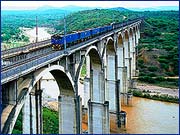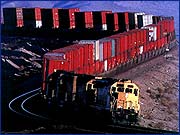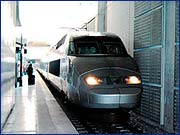CORPORATE PROFILE
Founding
The following questions probe essential issues in positioning a railway
for competitiveness and sustainablility:
What understanding do stakeholders need to gauge how the tangible
assets and intellectual property of an individual railway align with a
compelling trend toward global consistency?
By what intervention package should stakeholders position that railway
effectively?
In a world where global railway consistency is still maturing toward a
format that one could capture in industry best practices, what will be
the ultimate format of that consistency?
The answers to both questions are embedded in the systemic drivers
of the global railway industry.
Railway Corporate Strategy Close Corporation is rooted in its Managing
Director's passion to research, to understand, and to exploit fundamental
competitiveness drivers in the global railway industry, to promote sustainability
of the railway transport mode.
One can discern conspicuous differences among the world's railways, even
in comparable business sectors. Intuitively, and also by comparison with
other transport modes, such differences appear greater than they need
be. Although individual cases may seem to build on sound premises, they
do not aggregate to an industry that gives the appearance of a global,
consistent, whole.
Around the world, a multitude of diverse economies, societies, and territories,
accommodate railways. They have all exerted due influence on intangible
issues such as ethos, business models, organizational structures, and
so on. In addition, over time technological advances have rendered old
equipment obsolete, and advanced assets have become commercially available.
Nevertheless, at systemic level, the tangible residue of previous strategic
decisions includes an amazing assortment of configurations in the fields
of infrastructure layout, track gauge, permissible axle load, vehicle
gauge, coupling arrangements, brake systems, motive power types, energy
sources, authorization systems, and so on, not to mention an even greater
assortment of configurations in the service execution and customer relations
fields.
Analytical railway industry stakeholders question the negative impact
of unwarranted diversity, first on the ability of railways to relate meaningfully
to global logistics and mobility opportunities, second on economies of
scale in the railway equipment marketplace, and third on global railway
business interoperability. Founded in 2003, Railway Corporate Strategy
CC has addressed such issues through original research.
Archetypes of global railways
These pictures show heavy haul, heavy intermodal(or double stack)-, and
high-speed passenger trains.
They are the archetypes of emerging global line-haul railways.
Why are they archetypes?
What fundamental variables underlie their relations to each other?
Why are there only three archetypes?
How do urban railways in various forms (heavy rail, light rail, and trams)
relate to the three archetypes?
Contact us to find out more.
|


